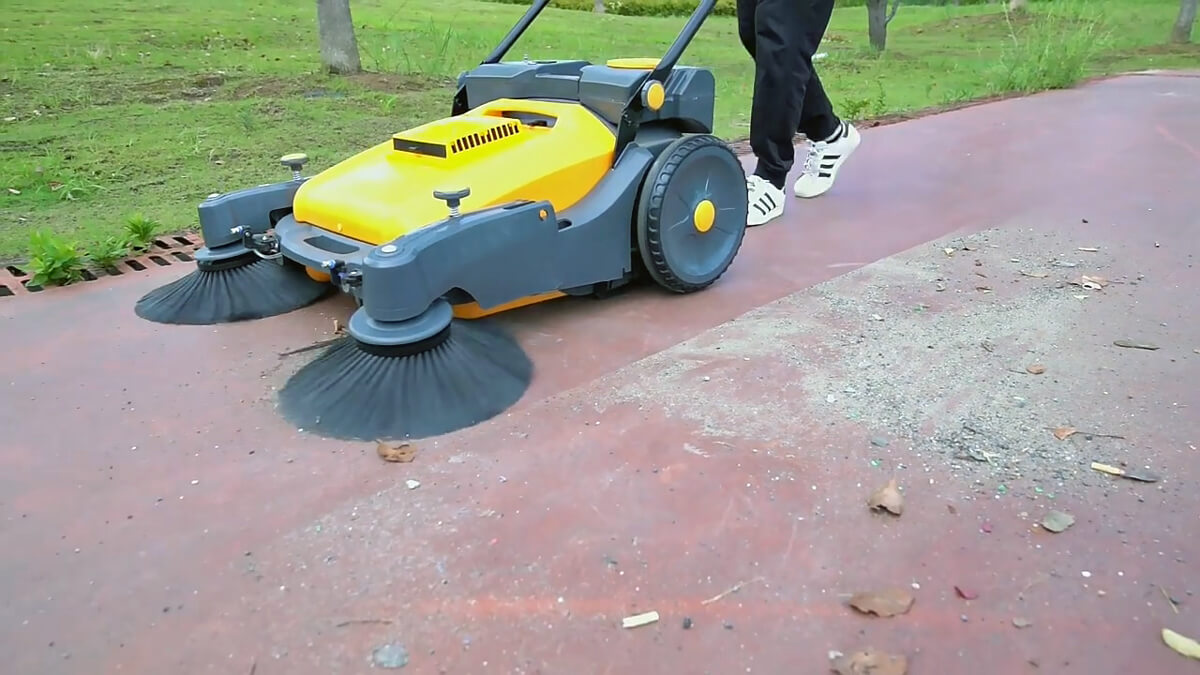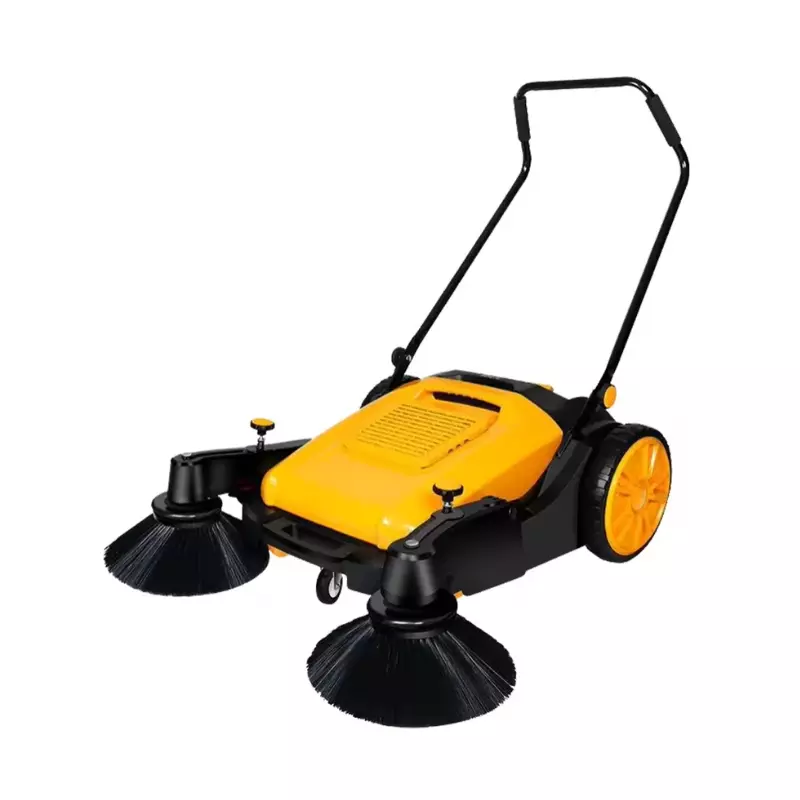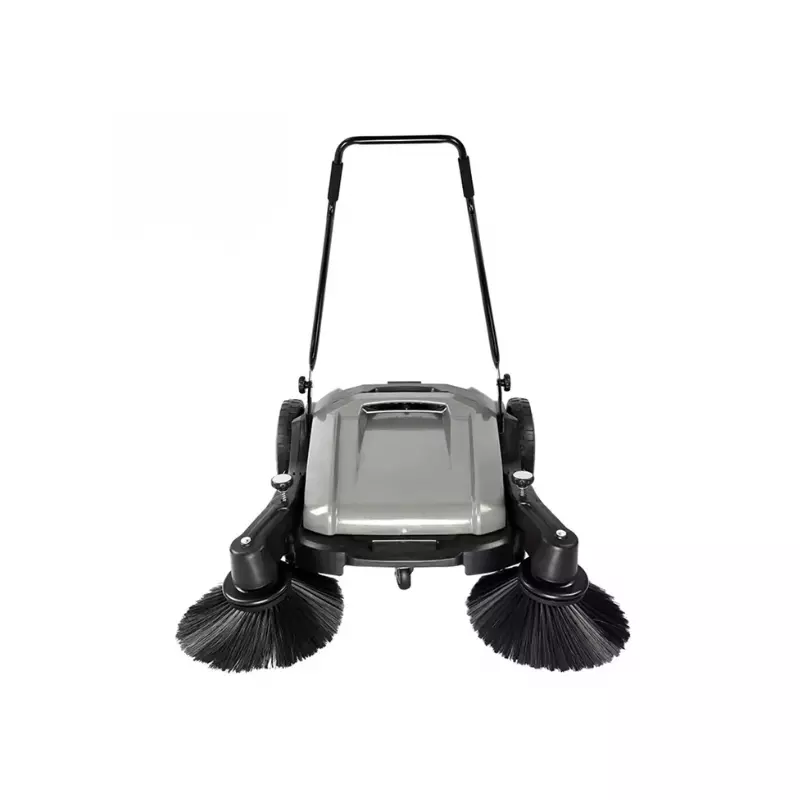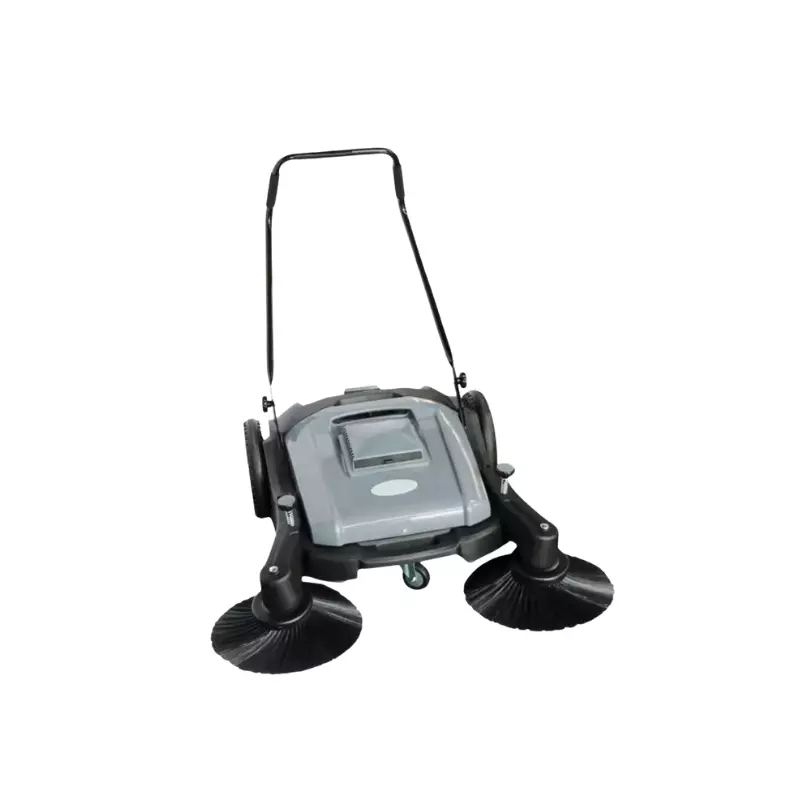This is a comprehensive guide to industrial sweepers. We will introduce different industrial sweepers, provide insights into how these machines operate and factors to consider when choosing a machine. We aim to help you make an informed decision to improve the cleanliness, safety and efficiency of your facility.
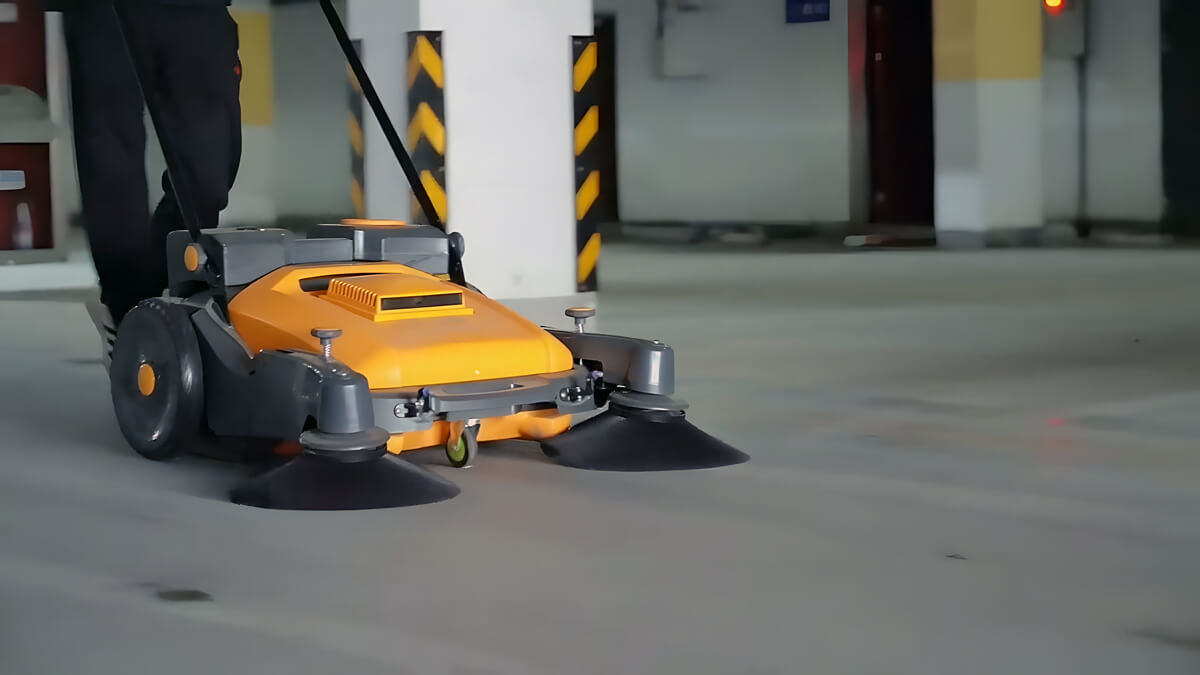
What is an industrial sweeper?
An industrial sweeper is a specialized cleaning machine designed to efficiently collect and remove dirt, dust, debris, and other forms of waste from vast industrial environments. These sweepers are ruggedly designed to meet the rigorous demands of environments such as manufacturing plants, warehouses, construction sites, and large commercial facilities. Basic functions of an industrial sweeper include:
Sweeping surfaces: Utilizes mechanical brushes to remove and collect debris from the floor.
Dust collection: Combines vacuum and filtration systems to capture fine dust particles and prevent them from becoming airborne.
Debris collection: Collected waste is collected and stored in an onboard hopper or container for easy disposal.
Industrial sweeper components and how they work
Most sweepers work by fusing a powerful vacuum system with a mechanical sweeper. Industrial sweepers consist of several key components that work together to improve cleaning efficiency. Understanding these components can provide insight into how these machines operate.
Main brush system: The main brush is typically a cylindrical (rotating) brush located underneath the machine. As the sweeper moves forward, the main brush rotates in the opposite direction of travel and agitates the floor surface, loosening dirt and debris, which is then lifted and directed to a collection area.
Side brush: This is a smaller brush located on either side of the sweeper. It rotates to sweep debris inward toward the main brush, extending the cleaning range to edges, corners, and walls.
Vacuum system and filtration system: The vacuum system has a powerful suction mechanism that creates an airflow that draws fine dust particles into the machine's filtration system and prevents them from escaping into the air.
Hopper / Collection container: This is an onboard compartment for storing collected debris, which temporarily holds dust and waste. Debris passes through the top of the brush into the hopper (usually located at the rear of the machine). The hopper is designed to facilitate easy removal and emptying.
Propel system: This is the mechanism that moves the sweeper forward or backward, including manual (push) sweepers: The operator pushes the machine to propel it forward. and self-propelled sweepers: equipped with a moving motor controlled by the operator.
This coordinated process enables industrial sweepers to effectively clean large areas, control dust and improve the overall environmental quality in industrial settings.
Types of industrial sweepers
Industrial sweepers are essential tools for the diverse cleaning needs of a wide range of industries. They are divided into push sweepers and ride-on sweepers, each type with specific features to meet different operating requirements.
Push sweepers
Push sweepers, also known as manual or walk-behind sweepers, are compact, maneuverable, and flexible cleaning machines. The operator uses a handle to control the machine's functions and guide forward movement (using traction or manual).
Advantages
Maneuverability: The compact size enables it to easily navigate in tight spaces, narrow aisles and around obstacles.
Ease of use: Simple controls and straightforward operation make it easy to use.
Cost-effective: Usually cheaper than large ride-on sweepers, suitable for use by small and medium-sized businesses.
Low maintenance: Fewer mechanical parts, lower maintenance requirements and costs.
Disadvantages
Low cleaning efficiency: Less efficient in large cleaning spaces due to slower operating speeds and smaller cleaning paths.
Operator fatigue: Manual propulsion and operation can lead to fatigue over long periods of use.
Debris Capacity: Smaller hoppers require more frequent emptying, which can interrupt cleaning tasks and potentially lead to workplace accidents.
Ideal environments and applications
Retail stores: Clean floors in supermarkets, boutiques, and department stores with high foot traffic.
Educational institutions: Keep schools, universities and training centers clean.
Hospitals and clinics: Ensure sanitary conditions in medical facilities.
Small Warehouses: Manage debris in storage areas and loading docks.
Hospitality venues: Keep hotels, restaurants and conference centers clean and tidy.
Recreational facilities: Clean cinemas, theaters, and stadiums between events.
BISON's walk-behind sweepers are available in two models: one with a dedicated filtration system and one without, as well as versions with battery or BISON gasoline engines.
Ride-on sweepers
Ride-on sweepers are large industrial machines with traction that are operated by a seated driver. Designed for efficiency and comfort, these sweepers can quickly cover large areas of ground and are ideal for large industrial and commercial environments. They are typically powered by batteries, diesel, gasoline or propane and feature powerful sweeping and vacuuming systems. This makes them high-performance sweepers that are ideal for medium to large surfaces.
Advantages
Efficiency: Ability to clean large areas quickly due to wider cleaning paths, faster operation speeds, and greater cleaning power.
Operator comfort: Seated operation reduces physical strain and allows operators to work a full shift.
Larger debris capacity: Larger hoppers minimize interruptions by reducing the frequency of emptying required, plus some machines have automatic dump systems.
Disadvantages
Size limitations: Larger footprints may limit accessibility in tight or cluttered spaces, while requiring larger areas for storage and charging.
Higher costs: Larger initial investment and potentially higher maintenance expenses, but this may be justified if productivity increases
Training requirements: Operators may need specialized training to operate the machine safely and effectively.
Idal environments and applications
Large warehouses and distribution centers: Effectively keep expansive storage areas clean.
Manufacturing plants: Manage dust and debris in heavy industrial environments to protect equipment and workers.
Parking lots and garages: Keep large indoor and outdoor parking facilities free of trash and hazards.
Airports and transportation hubs: Clean terminals, hangars, and baggage handling areas, covering large areas.
Stadiums and arenas: Quickly prepare venues for events by cleaning seating areas, concourses, and walkways.
Construction sites: Manage construction waste to improve safety and workflow efficiency.
BISON industrial ride-on sweepers include multiple series, which means there are a variety of battery, diesel, gasoline, or LPG-driven models to choose from.
Choosing the right industrial sweeper
Choosing the right industrial sweeper is crucial. These can be large ride-on sweepers or smaller push-type sweepers. BISON is here to help. With decades of experience and dedication to quality, we hope to help you choose the ideal industrial sweeper that fits your needs and budget. Here are the key factors and features to consider when choosing the right sweeper for your needs.
Size of cleaning area
Choosing the right sweeper size is crucial. If you use a sweeper that is too small for the area you want to clean, you will incur higher labor costs. If your sweeper is too large, it may also be difficult to clean in these tight spaces.
For areas such as small warehouses or workshops, a compact push-type sweeper may be sufficient. But larger facilities such as distribution centers or parking lots may require a ride-on sweeper with a wider cleaning path to cover the ground more effectively. Some companies may choose to have both a large ride-on sweeper and a small push-type sweeper. Finally, don’t forget to consider changes that may affect your cleaning needs, such as facility expansions or regulatory changes.
Frequency of use
Whether you plan to use your industrial sweeper daily or only occasionally will significantly impact the type of model you should consider. We recommend heavy users to go with our premium models, which are known for their ruggedness and resistance to wear and tear. If you need an industrial sweeper only occasionally, our affordable range of low-end models will be ideal.
Types of debris to collect
Fine dust and particles: A sweeper with an advanced filtration system is required to capture small particles. BISON sweepers with standard filtration systems are suitable for general debris and dust. For environments that require high air quality standards, you can choose advanced filtration systems (such as HEPA filters) that capture fine dust and allergens.
Large debris: Sweeping items such as leaves, gravel, or packaging materials may require a heavy-duty brush and larger hopper capacity.
Wet or sticky Materials: Look for a sweeper that is capable of wet sweeping or equipped with a scrubbing function.
Budget and cost considerations
Your budget range should be your priority. You need to determine the amount you are willing to spend upfront and then consider operating costs such as fuel consumption, battery life, maintenance, and replacement parts.
While this is a sizeable investment, remember that you are buying into durability, performance, and quality. BISON has a wide range of equipment to suit different price ranges. Our goal is to not only offer low prices, but also products that provide value for money.
Cleaning path width
For industrial sweepers, size is important. Narrower cleaning paths (20-30 inches) are ideal for smaller spaces or areas with obstructions. Wider cleaning paths (up to 70 inches) are ideal for open areas to reduce cleaning time. BISON has a wide range of models, plus we offer custom sizes to fit your unique needs.
Power source
Sweepers don’t plug into a wall, so they require a portable power source. There are two main power system options for industrial sweepers: engine and battery power.
Battery sweepers are great for indoor applications, running quietly and without emissions. They are compact and suitable for operating in tight spaces. However, battery-powered sweepers have limited run time, so you need to make sure the battery capacity meets your needs. It also can’t be used while charging.
A great option for saving production time is an internal combustion engine. Powered by gasoline, diesel, or propane, these industrial sweepers run longer and have more power for heavy debris. They have a rugged construction that can handle rough terrain and weather conditions. However, emissions and noise levels may limit indoor use. Operating costs may be much higher than with battery-powered sweepers, considering fuel and scheduled maintenance.
Hopper capacity
Consider where the hopper dumps. If the dumping area is hard to reach, consider purchasing a sweeper with a large hopper (over 9 cubic feet) to reduce unnecessary dumping. Smaller hoppers (up to 2 cubic feet) are suitable for areas with less debris accumulation.
Maneuverability and ergonomics
Functionality: Allows the operator to control various functions such as speed, brush rotation, and vacuum settings.
Steering and controls: Easy-to-use controls reduce operator fatigue and training time.
Size and turning radius: Compact models with tight turning capabilities are better suited for cluttered spaces.
Operator comfort: Adjustable seats, handlebars, and low vibration levels increase comfort during extended use.
Durability and build quality
Construction materials: Durable materials like steel frames withstand frequent use and harsh conditions.
Quality components: Reliable motors, brushes, and parts reduce downtime and maintenance costs.
Warranty and support: Peace of mind with a solid warranty and responsive customer service.
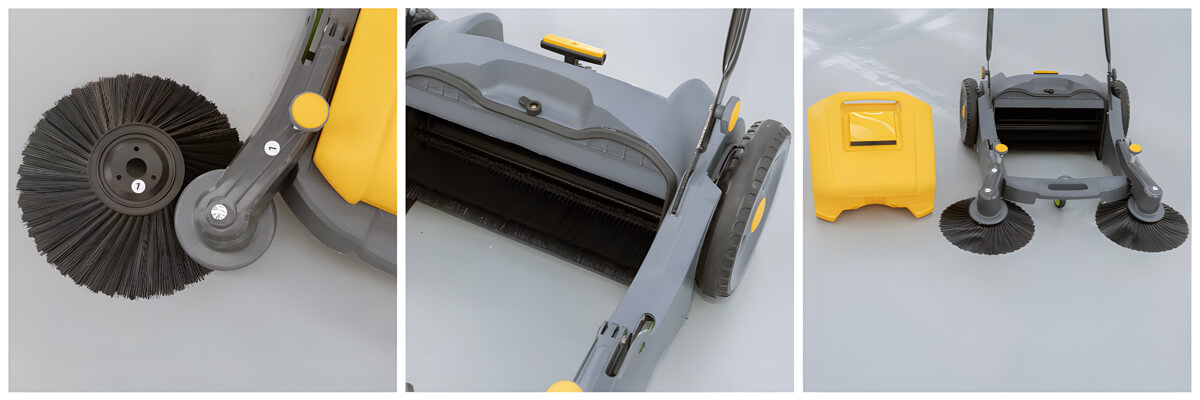
In summary, push-type sweepers are ideal for smaller spaces and delicate cleaning tasks, with maneuverability and cost savings. In contrast, ride-on sweepers excel in large-scale applications where speed and efficiency are critical, providing powerful performance and operator comfort.
Industrial sweepers can significantly reduce the time and labor required to clean large areas, thereby improving operational efficiency. They effectively remove dust, debris, and hazardous materials, which can help create a safer work environment, reduce slip hazards, and improve air quality. In addition, a clean facility can also show a professional image to customers and visitors, which has a positive impact on your business.
As a professional industrial sweeper manufacturer in China, BISON is committed to providing high-quality, reliable industrial cleaning solutions to meet the diverse needs of different industries. Our wide range of industrial sweepers uses advanced technology, durable construction, and user-friendly design to ensure excellent performance and lifespan.
Contact us now.
